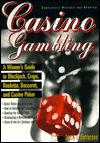
Casino Gambling : A Winner's Guide to Blackjack, Craps, Roulette, Baccarat, and Casino Poker

The Key to Attaining a Real Advantage at Dice Control
The Dice Control Revolution is in full swing. It is now an accepted fact that craps players possessing the skill of dice setting, gripping and throwing the dice so that they travel side-by-side Jerry Patterson is an internationally known gaming author, player, and instructor and has written five gambling books. The two most popular are 'Casino Gambling: A Winner’s Guide to Blackjack, Craps, Roulette, Baccarat and Casino Poker 'and 'Blackjack: A Winner’s Handbook.' Jerry's website is www.sharpshootercraps.com in orbit, at the same velocity, and land softly with minimal "splatter," can overcome the house edge at casino craps.
Jerry Patterson is an internationally known gaming author, player, and instructor and has written five gambling books. The two most popular are 'Casino Gambling: A Winner’s Guide to Blackjack, Craps, Roulette, Baccarat and Casino Poker 'and 'Blackjack: A Winner’s Handbook.' Jerry's website is www.sharpshootercraps.com in orbit, at the same velocity, and land softly with minimal "splatter," can overcome the house edge at casino craps.
Dice Control can be defined simply as the skill of throwing the dice more than the random 6 times including the seven out in the point cycle. The statistics speak very loudly in this low, house-edge game: If you can roll 6.14 times in the point cycle, you break even; roll eight times including the seven-out and you have a double digit edge approaching 17%.
Before I get to the key to learning how to control the dice, let me review the simple 4-step process of dice control:
Dice Control Step 1: You set the dice to move the losing sevens out of the way, to the hubs or ends, with hardways showing on all four faces. The Hardway Set is just one of the many sets you can use, but it has proven itself over the years as the very best set for newcomers to dice control
Dice Control Step 2: You grip the dice lightly to minimize skin contact (drag) with the surface of the cubes. If you are just starting, I recommend the one-finger front grip – middle finger placed near top of crack with thumb behind. You can find other grips defined in Sharpshooter’s excellent book, How to Control the Dice.
Dice Control Step 3: You pick up the dice while observing your projected landing area about 6 inches in front of the back wall.
Dice Control Step 4: You launch the dice into orbit, perpendicular to the sides of the table and parallel to the back wall.
It is this fourth step that we are concerned about in this article. To secure an edge over the house, your objective is to launch the dice at the optimum angle to accomplish a “soft landing” and minimize the random motion of the dice after they collide with the back wall pyramids and come to rest.
Sharpshooter has stated in the Sharpshooter/PARR Dice Control Course that this optimum launch angle is 45 degrees. The dice should leave your hand at the required 45-degree angle, rotating side by side at the same rate of speed.
This 45-degree angle is key to your control, your soft landing with minimal random “splatter,” and, thus, to your edge over the house.
The Question is: How can you be sure that you have launched at 45 degrees or as close as possible thereto?
The answer is in the Charts below showing how high to throw the dice above the table bed to achieve the optimum 45 degrees. Heights for various table lengths and throwing positions are shown.
It is suggested that you practice at home to get a feel for the heights above the table bed needed to attain the 45-degree angle. This should be part of your normal practice of setting, gripping and throwing with control.
How high do you throw the dice to achieve a Perfect Throw?
These values were calculated using the 45° launch angle and the parabola equations in a post to the Sharpshooter/ PARR List Server. The height values are based on throwing from stick left, stick right and table end.
|
Table Length - ft.
|
Stick Left or Right Throwing Distance - ft. |
Height (ft) above table bed |
|
12
|
6
|
1.5
|
|
14
|
7
|
1.75
|
|
16
|
8
|
2.0
|
|
Table Length – ft.
|
Table End Throwing distance – ft.
|
Height (ft) above table bed
|
|
12
|
12
|
3.0
|
|
14
|
14
|
3.5
|
|
16
|
16
|
4.0
|
Copyright © 2003-2006 by Jerry Patterson
